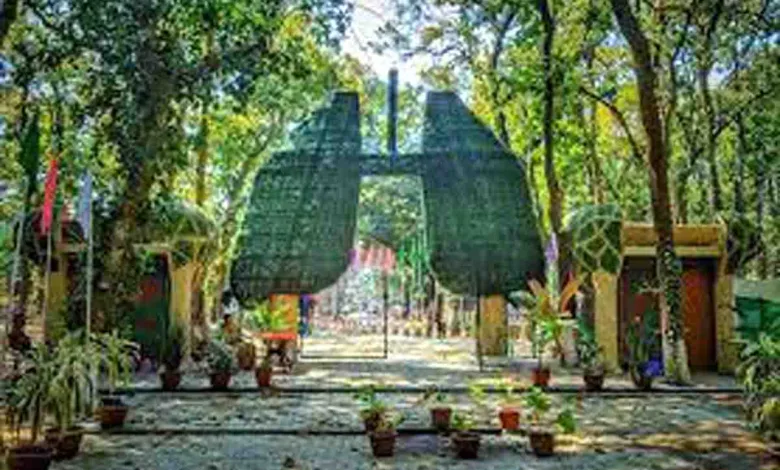Oxygen Park to combat pollution- Tripura shows the way

GUEST COLUMN
 VK Bahuguna
VK Bahuguna
Urbanisation is an integral part of the modern doctrine of development and India is no exception. Only 7.6 million people lived in urban areas in 1950 in the world, which went up in 2014 to 3.9 billion. In 2009 more people were living in urban areas (3.42 billion) than rural areas (3.41 billion) in the world. In India in 1951 only 17.3 per cent of our population lived in urban areas which went up to 31.2 per cent in 2011. In 2019 47.6 crore people lived in urban areas in our country and the number is rising every year. The rising population and unemployment is causing gradual migration of people from rural to urban areas in search of livelihood and better educational and health facilities. This is also causing an increase in urban poverty ration and environmental pollution. The urban bodies have been trying hard to create green lungs to meet the environmental necessities to combat pollution and create oxygen for better breath. There is a necessity of balancing the ecological and the economic ecosystems in urban areas.
As more and more urbanisation takes place environmentally poor air, water and sewage disposal are the main challenges with huge demand and consumption of energy. The problem is getting accentuated by the migration of people to cities. Such a situation creates a lot of health issues among the public including communicable and non communicable diseases like heart and asthma problems. The civic amenities are awfully inadequate and rather haphazard and year after year we can see the deluge we find in cities like Mumbai, Chennai and Delhi during the rainy season. Now people are realising the importance of greenery. The erstwhile royal family of Mysore laid the foundation of green cities in India historically and today we find huge old trees and water bodies in Mysore and Bengaluru. Later on, Gandhinagar, Hyderabad, Jamshedpur and Delhi are the other pioneering cities in creating greenery. But for the greenery the air quality Index of Delhi during the time of stub burning would have crossed 1,000. Now all other cities are also trying to create parks and gardens
In such a situation this writer would like to discuss how the tiny state of Tripura is leading the nation by creating oxygen parks. As the name suggests it focuses on awareness generation and motivating people to plant more trees and integrate the local culture and history with it so that an effective infrastructure is created to combat urban problems and meet the goals of climate change. The Agartala Oxygen Park was developed over a 30 hectare area at Gandhigram-Salbagan area which was full of beautiful Sal forests created by the erstwhile royal family of Tripura before independence and merger of Tripura in Indian Union. The greenery of Sal forests is a big positive for the people of Tripura. The park has everything for every section of society — children, youth, researchers, bird watchers and tribal/ anthropologists and is a paradise for morning and evening walkers to breathe the fresh air. North-Eastern States are full of orchids and home to more than 55 orchid species. The role of orchids is very vital for the stability of the ecosystem. In tandem with bees they help in pollination and in several other functions of the ecosystem.
The local tribal people have special fascination and cultural value for the orchids as they make their life colourful as they are used for medicines and religious ceremonies. Sikkim leads in the management and commercialisation of orchids and several hundred people earn livelihood from orchid cultivation. In Tripura the Forest department has created a world class state of art orchidarium inside the park where a large number of orchids are displayed and are attracting huge crowds of students and nature lovers. Apart from orchids the Forest department has also created a fernarium which may be the first attempt in the country to conserve the ecologically sensitive ferns. The park has more than 100 bird species many of which are unique to the area.
Inside the park there is a gallery explaining the customs and traditions of all the 18 tribes of Tripura which is a big attraction for the tourists to understand the social fabric of Tripura. A forester’s memorial reminds the people of the sacrifice by the forest staff who laid down their life in protecting the forests and wildlife. The concept of oxygen park is not just limited to a recreational centre but encompasses a holistic way to not only educate the people but also to create a movement for adapting and mitigating the threat of climate change and making people conscious of everything they do in their day to day life. In fact, in each State and in every city should have an oxygen park depicting the cultural and environmental strength of the area and a series of such park should be made both in urban and rural areas and integrated with the industrial development, ecotourism and present a package of environmental awareness to people so that the future generations are made aware of our environmental and cultural heritage and at the same time create economic opportunities and prepare people for climate change adaptation and mitigation. The vagaries of climate change have reached every home now and every household must learn to cope with it. So far the Forest departments have been mostly concentrating on trees/wildlife and forests but now the department should have an integrated set up to promote ecotourism in conjunction with harnessing the beauty of landscape for larger conservation value and economic gains both in urban as well as rural landscape.
(The author is former director general of the Indian Council of Forestry Research and Education. Views expressed are personal)






